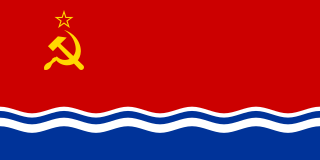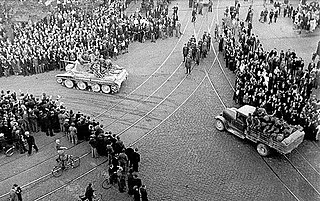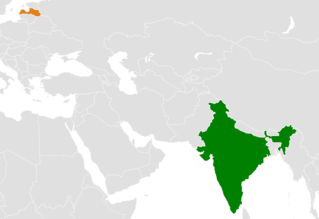
Latvia, officially known as the Republic of Latvia, is a country in the Baltic region of Northern Europe. It is one of the Baltic states; and is bordered by Estonia to the north, Lithuania to the south, Russia to the east, Belarus to the southeast, and shares a maritime border with Sweden to the west. Latvia covers an area of 64,589 km2 (24,938 sq mi), with a population of 1.9 million. The country has a temperate seasonal climate. Its capital and largest city is Riga. Latvians belong to the ethno-linguistic group of the Balts; and speak Latvian, one of the only two surviving Baltic languages. Russians are a prominent minority in the country, at some 24% of the population.

The foreign relations of Latvia are the primary responsibility of the Ministry of Foreign Affairs. Today's Republic of Latvia regards itself as a continuation of the 1918–1940 republic. After the declaration on the restoration of its full independence on August 21, 1991, Latvia became a member of the United Nations on September 17, 1991, and is a signatory to a number of UN organizations and other international agreements. Latvia welcomes further cooperation and integration with NATO, European Union, OECD and other Western organizations. It also seeks more active participation in UN peacekeeping efforts worldwide.

The Baltic states, also known as the Baltic countries, Baltic republics, Baltic nations, or simply the Baltics, is a geopolitical term, typically used to group the three sovereign states on the eastern coast of the Baltic Sea: Estonia, Latvia, and Lithuania. The term is not used in the context of cultural areas, national identity, or language, because while the majority of people in Latvia and Lithuania are Baltic people, the majority in Estonia are Finnic. The three countries do not form an official union, but engage in intergovernmental and parliamentary cooperation. The most important areas of cooperation among the three countries are foreign and security policy, defence, energy, and transportation.

The Singing Revolution is a commonly used name for events that led to the restoration of independence of the Baltic states of Estonia, Latvia, and Lithuania from the Soviet Union at the end of the Cold War. The term was coined by an Estonian activist and artist, Heinz Valk, in an article published a week after 10–11 June 1988, spontaneous mass evening singing demonstrations at the Tallinn Song Festival Grounds. Later, all three countries joined NATO and EU in 2004.

The Latvian Soviet Socialist Republic, also known as Soviet Latvia or Latvia, was a republic of the Soviet Union.

The occupation of the Baltic states involved the military occupation of the three Baltic states—Estonia, Latvia and Lithuania—by the Soviet Union under the auspices of the 1939 Molotov–Ribbentrop Pact in June 1940. They were then annexed into the Soviet Union as constituent republics in August 1940, though most Western powers and nations never recognised their incorporation. On 22 June 1941, Nazi Germany attacked the Soviet Union and within weeks occupied the Baltic territories. In July 1941, the Third Reich incorporated the Baltic territory into its Reichskommissariat Ostland. As a result of the Red Army's Baltic Offensive of 1944, the Soviet Union recaptured most of the Baltic states and trapped the remaining German forces in the Courland pocket until their formal surrender in May 1945.

The prime minister of Latvia is the most powerful member of the Government of Latvia, and presides over the Latvian Cabinet of Ministers. The prime minister is nominated by the president of Latvia, but must be able to obtain the support of a majority of the Saeima (parliament).

The Latvia national football team represents Latvia in international football and is controlled by the Latvian Football Federation, the governing body for football in Latvia. They have never qualified for the FIFA World Cup, however, they qualified for the European Championship in 2004 under head coach Aleksandrs Starkovs.

The Bank of Latvia is the central bank of Latvia. It is among the nation's key public institutions and carries out economic functions as prescribed by law. It was established in 1922.

Coat of arms of Republic of Latvia was officially adopted by the Constitutional Assembly of Latvia on July 15, 1921, and was in official use from August 19, 1921. It was created using new national symbols and elements of coats of arms of Polish and Swedish Livonia and of the Duchy of Courland and Semigallia. Thus the coat of arms combines symbols of Latvian national statehood, as well as symbols of its historical regions. The Latvian national coat of arms was designed by the Latvian artist Rihards Zariņš.

The Latvian War of Independence, sometimes called Latvia's freedom battles or the Latvian War of Liberation, was a series of military conflicts in Latvia between 5 December 1918, after the newly proclaimed Republic of Latvia was invaded by Soviet Russia, and the signing of the Latvian-Soviet Riga Peace Treaty on 11 August 1920.

The Constitution of Latvia is the fundamental law of the Republic of Latvia. Satversme is the oldest Eastern or Central European constitution still in force and the sixth oldest still-functioning republican basic law in the world. It was adopted, as it states itself in the text, by the people of Latvia, in their freely elected Constitutional Assembly of Latvia on 15 February 1922 and came into force on 7 November 1922. It was heavily influenced by Germany's Weimar Constitution and the Swiss Federal Constitution. The constitution establishes the main bodies of government ; it consists of 115 articles arranged in eight chapters.

The Latvian Socialist Soviet Republic was a short-lived socialist republic formed during the Latvian War of Independence. It was proclaimed on 17 December 1918 with the political, economic, and military backing of Vladimir Lenin and his Bolshevik government in the Russian SFSR. The head of government was Pēteris Stučka with Jūlijs Daniševskis as his deputy.

The Soviet occupation of Latvia in 1940 refers to the military occupation of the Republic of Latvia by the Soviet Union under the provisions of the 1939 Molotov–Ribbentrop Pact with Nazi Germany and its Secret Additional Protocol signed in August 1939. The occupation took place according to the European Court of Human Rights, the Government of Latvia, the United States Department of State, and the European Union. In 1989, the USSR also condemned the 1939 secret protocol between Nazi Germany and herself that had led to the invasion and occupation of the three Baltic countries, including Latvia.

The Declaration "On the Restoration of Independence of the Republic of Latvia" was adopted on 4 May 1990, by the Supreme Soviet of the Latvian SSR. The Declaration stated that, although Latvia had de facto lost its independence in 1940, when it was annexed by the Soviet Union, the country had de jure remained a sovereign country as the annexation had been unconstitutional and against the will of the Latvian people. Therefore, it resolved that the Molotov–Ribbentrop Pact and the Soviet occupation of Latvia in 1940 were illegal. It also asserted that the heavily rigged 1940 elections were illegal and unconstitutional, and that all acts of the "People's Saeima" chosen at that election–including the request to join the Soviet Union on 21 July 1940–were ipso facto void.

The president of Latvia is head of state and commander-in-chief of the National Armed Forces of the Republic of Latvia.

The Latvian nationality law is based on the Citizenship Law of 1994. It is primarily based on jus sanguinis.

Latvia–Russia relations is the bilateral foreign relations between Latvia and Russia. Latvia has an embassy in Moscow and two consulates general: in Pskov and Saint Petersburg. Russia has an embassy in Riga and two consulates general: in Daugavpils and Liepāja.

The Government of Latvia is the central government of the Republic of Latvia. The Constitution of Latvia ouftlines the nation as a parliamentary republic represented by a unicameral parliament (Saeima) and the Cabinet of Ministers of the Republic of Latvia, which form the executive branch of the Government of Latvia.

India - Latvia relations refer to the bilateral relations between India and Latvia. Two countries established diplomatic relations at 1991, following the independence of Latvia. India's mission to Latvia is accredited from the Indian embassy in Stockholm, Sweden; while Latvia maintains an embassy and a consulate in New Delhi.
















